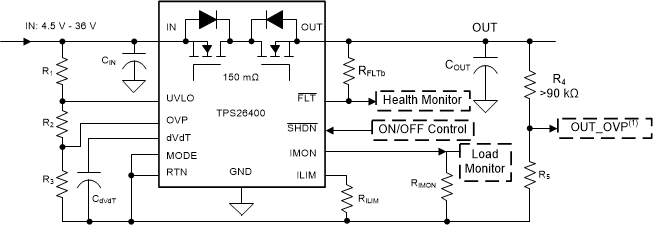-
TPS2640 42-V, 2-A eFuse with Integrated Reverse Input Polarity Protection
- 1 Features
- 2 Applications
- 3 Description
- 4 Revision History
- 5 Device Comparison
- 6 Pin Configuration and Functions
- 7 Specifications
- 8 Parameter Measurement Information
-
9 Detailed Description
- 9.1 Overview
- 9.2 Functional Block Diagram
- 9.3
Feature Description
- 9.3.1 Undervoltage Lockout (UVLO)
- 9.3.2 Overvoltage Protection (OVP)
- 9.3.3 Reverse Input Supply Protection
- 9.3.4 Hot Plug-In and In-Rush Current Control
- 9.3.5 Overload and Short Circuit Protection
- 9.4 Device Functional Modes
-
10Application and Implementation
- 10.1 Application Information
- 10.2 Typical Application
- 10.3 System Examples
- 10.4 Do's and Dont's
- 11Power Supply Recommendations
- 12Layout
- 13Device and Documentation Support
- 14Mechanical, Packaging, and Orderable Information
- IMPORTANT NOTICE
Package Options
Mechanical Data (Package|Pins)
Thermal pad, mechanical data (Package|Pins)
- PWP|16
Orderable Information
TPS2640 42-V, 2-A eFuse with Integrated Reverse Input Polarity Protection
1 Features
4.2-V to 42-V operating voltage, 45-V absolute maximum
- Integrated reverse input polarity protection down to –42 V
- Zero additional components required
- Integrated back to back MOSFETs with 150-mΩ total RON
- 0.1-A to 2.23-A adjustable current limit (±5% accuracy at 1 A)
- Load protection during surge (IEC 61000-4-5) with suitable TVS
- IMON current indicator output (±8.5% accuracy)
- Low quiescent current, 300-μA in operating, 20-μA in shutdown
- Adjustable UVLO, OVP cut off, output slew rate control
- Reverse current blocking
- Available in easy-to-use 16-pin HTSSOP and 24-pin VQFN packages
- Selectable current-limiting fault response options (auto-retry, latch off, circuit breaker modes)
2 Applications
- HMI power protection in factory automation
- Fire safety systems
- Electronic thermostats and video doorbells
- Industrial PCs
- Elevators
3 Description
The TPS26400 devices are compact, feature rich high voltage eFuses with a full suite of protection features. The wide supply input range of 4.2 to 42 V allows control of many popular DC bus voltages. The device can withstand and protect the loads from positive and negative supply voltages up to ±42 V. Integrated back to back FETs provide reverse current blocking feature making the device suitable for systems with output voltage holdup requirements during power fail and brownout conditions. Load, source and device protection are provided with many adjustable features including overcurrent, output slew rate and overvoltage, undervoltage thresholds. The internal robust protection control blocks along with the high voltage rating of the TPS26400 helps to simplify the system designs for Surge protection.
A shutdown pin provides external control for enabling and disabling the internal FETs as well as placing the device in a low current shutdown mode. For system status monitoring and downstream load control, the device provides fault and precise current monitor output. The MODE pin allows flexibility to configure the device between the three current-limiting fault responses (circuit breaker, latch off, and Auto-retry modes).
The device is available in a 5-mm × 4.4-mm 16-pin HTSSOP as well as 5-mm x 4-mm 24-pin VQFN package and are specified over a –40°C to +125°C temperature range
| PART NUMBER | PACKAGE(1) | BODY SIZE (NOM) |
|---|---|---|
| TPS26400 |
HTSSOP (16) |
5.00 mm × 4.40 mm |
| TPS26400 |
VQFN (24) |
5.00 mm × 4.00 mm |
 Simplified Schematic
Simplified Schematic Reverse Polarity Protection
with –42-V Input
Reverse Polarity Protection
with –42-V Input